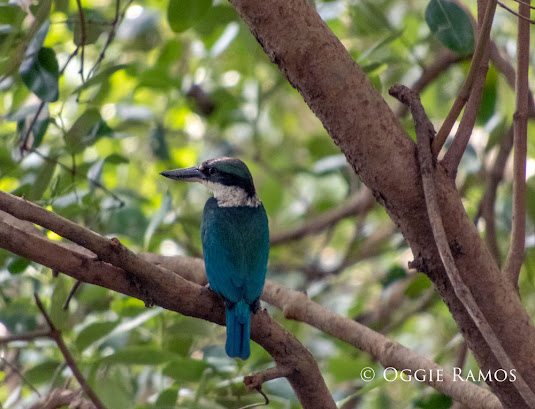 |
| Lifer #1 - Yellow Bittern at Pond 1 |
 |
| Chinese Egret |
 |
| Common Kingfisher |
It's not easy to photograph the egrets (and for that matter, the other birds in the park) as they are skittish, with a rather long-distance comfort zone from the nearest human they see. Too often, even the 1200mm equivalent focal length of my Nikon B700 camera wouldn't suffice to take a decent capture, so eating snacks at the gazebo/hut, I thought of just enjoying the trip and the experience, nevermind if I wouldn't be able spot a lifer or add a bird to my life list.
And oh, I was also lugging my dumbbell (about 4-5 pounds) of a dinosaur Nikon DSLR -- my 12-year old D300 paired to an even older Nikkor 70-200mm f/2.8 lens (even with a 2x teleconverter, the 400+mm focal zoom wouldn't suffice)
Not that we weren't able to spot 'em birds. Early on, we spotted Chinese egrets airborne and perched. Ditto albino white pipits in the trees (too tiny and skittish to shoot up in the treetops). We circled the trail from the boardwalk to Freedom Island, then onwards to seaside and Pond 1. We got lucky at Pond 1, seeing quite a lot of birds frequenting the shallows and the nearby bushes -- a Yellow Bittern (Ixobrychus sinensis) in particular with its yellowish brown pattern catching the eye when it takes flight across the water.
We saw rather commonplace birds such as the Maria Capra (Philippine Pied Fantail/Rhipidura nigritorquis) which was really plentiful here; also the Yellow Vented Bulbuls, Long Tailed and Brown Shrikes. I'm not one to take these birds for granted no matter if I spot them right here in Makati. Ferdz was able to spot and photograph some Arctic Warblers/Himantopus himantopus (I heard them but wasn't able to photograph any though I've seen some back at Sycip Park a month or so ago).
 |
| Collared Kingfisher |
 |
| Two Yellow Vented Bulbuls wading together |
Info on the LPPCHEA wetlands culled en toto from the Society for the Conservation of Philippine Wetlands website:
• The Las Piñas – Parañaque Critical Habitat and Ecotourism Area (LPPCHEA) is a 175 hectare protected area located between the coordinates 14.481158, 120.971586 and 14.502763, 120.988237 or the southwest portion of Metro Manila and Manila Bay.
• LPPCHEA divided into 2 main landmasses: Long Island is at the southwest portion of the LPPCHEA in Las Piñas City and Freedom Island is at the northeast part in Parañaque City.
 |
| Lifer #2: Common Sandpipers |
• Predominantly covered by mudflats, LPPCHEA also has brush, grass, beach, dirt, and mangrove areas. Mangroves are the most prevalent plant species (8 species in total) in the area covering about 30 hectares.
• Around 114 hectares of mudflats surrounding mangrove areas provide the opportunity for sources of food for about 5,000 birds per day. The count of different bird species range from 54 from the Department of Environment and Natural Resources – National Capital Region (DENR-NCR) to 80 bird species by the Wild Bird Club of he Philippines.
 |
| Lifer 3: Black-winged Stilts |
• Of these bird species, The Philippine Duck (Anas luzonica) and Chinese Egret (Egretta eulophotes) are vulnerable or is likely to become endangered unless the circumstances threatening its survival and reproduction improve.
 |
| Lifer #4: Spotted Dove |
• Also noteworthy are the Black-Winged Stilts (Himantopus himantopus) population in LPPCHEA which is estimated at about 1% of the total global population of Black-Winged Stilts.
• Twenty-nine migratory bird species were counted by DENR-NCR as migratory including the Siberian Rubythroat (Luscinia calliope). LPPCHEA lies within the migration path of migrant birds escaping the harsh Siberian Winter. Migratory birds feast on mudflat species from August to April.
 |
| Pensive Brown Shrike very up close |
Note: Entrance is free to the public. However, guests should secure a permit online beforehand. LPPCHEA contact numbers: 0995 056 1678 • (02) 435-2509
POSTSCRIPT:
Upon review and confirmation, it turns out we saw more lifers than we first accounted for. In my case, instead of two, I saw four lifer birds: Yellow Bitterns, Spotted Doves (which I originally thought were Zebra Doves), Common Sandpipers, and Black-Winged Stilts.
